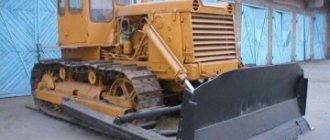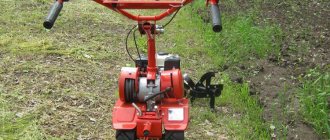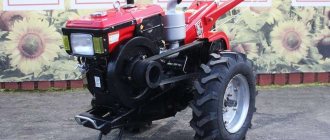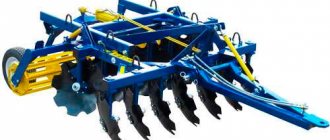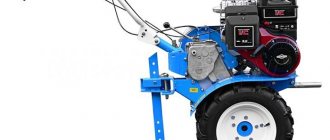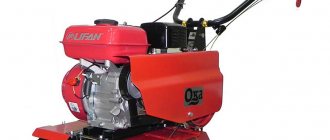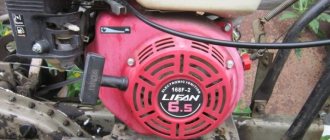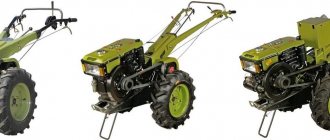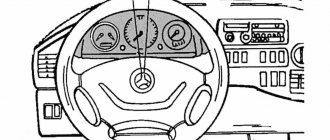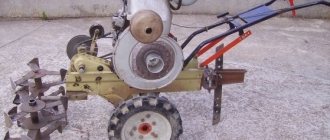Walk-behind tractors have long become quite commonplace for many rural farmers, working in their garden. They begin in the spring, when many summer residents head to their country estates to “reanimate” their plots after a long winter.
It is extremely difficult to do this manually, which is why many resort to using such units.
The domestically produced Luch walk-behind tractor is perfectly suited for these purposes.
The simplicity of the design makes it much easier to operate the unit, as well as carry out maintenance and repairs.
At the same time, its performance characteristics are quite sufficient for carrying out the main range of agricultural work.
About the manufacturer and history of the Luch MB-1 model
The Luch MB-1 walk-behind tractor is in the same line with several other modifications of such equipment, which differ only in names, but are very similar both in appearance and in the design of all parts and assemblies. And the factory index for all is the same - “MB-1” (there is also an absolutely identical version, differing only in the shape of the fuel tank - “MB-5040”).
The names for their products were chosen by manufacturing enterprises, many of which belonged to the military-industrial complex and the aviation industry. The manufacturer of the Luch MB-1 walk-behind tractor was the Perm Production Association Motorostroitel named after Sverdlov (now JSC UEC Perm Motors), a manufacturer of aircraft engines.
The eighties and nineties of the twentieth century became for this plant the time when its products “came down from heaven to earth.” The line of manufactured equipment has been replenished with new models of gas turbine equipment intended for operation as part of gas pumping units of compressor stations of main gas pipelines and gas turbine power plants.
And also, in the light of the general “fashion for conversion” - consumer goods, among which, since 1985, was the Luch MB-1. In previous years, there was no point in producing walk-behind tractors in the Soviet Union: there was no market demand for them. Personal gardens were plowed and cultivated with collective farm tractors, either free of charge or for a reasonable fee. There was always a lot of gasoline and diesel fuel in farms, and they cost mere pennies. The years of destruction of the previous agricultural system throughout the country - the second half of the 80s and all of the 90s - became the time for the spread of the production and use of domestic walk-behind tractors.
Main products.
Currently (more precisely, since the beginning of the 2000s), Luch walk-behind tractors and other non-core “small” equipment have been removed from the lists of products manufactured by the Perm plant: it again produces only turbojet aircraft engines and industrial gas turbine mechanisms. This is also a nationwide trend: the production of walk-behind tractors has been abandoned everywhere at similar enterprises.
However, many of the Luch MB-1 walk-behind tractors sold back in the last century are not only in working condition, but also work season after season without serious breakdowns; pass from hand to hand and are considered a familiar assistant in the households of families from different regions of Russia and the CIS. Not every mechanism is able to demonstrate such durability in use.
The design of this equipment is so universal that analogues of the Luch MB-1 walk-behind tractor are still produced by the Chinese, as well as several enterprises in Russia that, under the guise of their own production, make these walk-behind tractors from the same Chinese parts and components.
How to design a trencher?
A homemade trencher is a mounted attachment to a walk-behind tractor that allows you to quickly and effortlessly dig trenches and holes. It is a kind of compact excavator that is maneuverable and economical. Moves on wheels or tracks. The digging attachment allows you to dig trenches and holes even in frozen ground . The walls of the trenches are smooth, without crumbling. The developed soil is light and crumbly, it can be used for backfilling. Two cutters are attached to the front suspension, and a shovel is attached to the rear suspension for extracting soil from the trench. Safety guards must be secured to the cutting discs and chain drive. Using the same principle, a drill attachment is made from a metal rod and plates.
Several types of walk-behind snow blowers are used to clear snow:
Brief description of the walk-behind tractor, its purpose and scope of application
The Luch MB-1 walk-behind tractor is a compact, relatively lightweight unit for cultivating soil in personal plots and vegetable gardens, as well as for some other agricultural work. It is as simple as possible in design and quite convenient to use. Maintenance and repair are also not something complicated, requiring special knowledge or training. All you need to do is read the instruction manual. And spare parts are available and inexpensive.
Initially, the Luch MB-1 walk-behind tractor is equipped only with a soil cultivator designed for loosening and turning over the soil. But, complete with other additional mounted implements, purchased separately, this walk-behind tractor can not only cultivate, but also plow light “garden” soils; harrow; cut and clear furrows, hill up and weed rows; dig up potatoes and other root vegetables; mow; transport goods.
The compatibility of the walk-behind tractor with additional attachments is good, but when using them with the MB-1, of course, you must carefully follow the instructions contained in the operating manual for each attachment. A powerful and economical four-stroke engine allows you to use the walk-behind tractor in various household works.
Spare parts
The new walk-behind tractor comes with a specific list of parts required for further operation. Due to the fact that the production of these walk-behind tractors has been discontinued, this opportunity has also disappeared.
Basically, you can only purchase Beam from your hands, or on Internet sites specializing in the sale of special equipment.
Spare parts
The Luch walk-behind tractor, spare parts for which can now be purchased on the Internet, was supplied with a coulter, a set of cutters, and instructions for working with it. In addition, this kit included certain consumables:
- Washers and nuts.
- Limiter.
- Latch.
- Bracket.
- Kingpin.
- Belts, etc.
Design of the Luch MB-1 walk-behind tractor
Structurally, this walk-behind tractor consists of the following main parts: engine; clutch mechanism; gearbox; handles with controls; two tire wheels (or four cultivators). Details about the engine are given below. the clutch mechanism is designed to transmit the energy of the crankshaft torque from the engine to the gearbox and consists of two belts; forward pulley; reverse pulley; drive pulley; gear pulley, rods; forward and reverse levers, and springs.
The gearbox is designed to change the gear ratio and transfer rotational energy from the gearbox pulley to the wheels and working equipment. The chain reducer consists of two halves of the housing; chains; shift shaft; shift knobs; three blocks of sprockets and an output shaft.
The controls located on the handles are used to change the operating modes of the engine and the direction of movement of the walk-behind tractor. They consist of: the steering wheel itself; motor control lever; gear shift knobs. The steering wheel is attached with four bolts to the gearbox angles, and it is equipped with height adjustment.
The engine control lever is attached to the right handlebar with a screw, which is connected to the throttle valve of the regulator by a cable through a lever and a spring. On the left handle of the steering wheel, on top, there is a forward lever, which is connected to the forward pulley through a rod, chain and spring. And below, on the same left handle, there is a reverse lever, which is connected through a chain, rod and spring to the lever on which the reverse pulley is installed. The transmission provides operation in 2 forward and 2 reverse gears.
The wheels on the Luch MB-1 walk-behind tractors are either pneumatic or cast rubber, size 4.00×10″. The outer part of the tread is most often made in the form of a traditional herringbone, and when installing such wheels on a walk-behind tractor, they must be placed with the corners forward. And to get the best results when plowing, hilling and digging up root crops, it makes sense to replace rubber wheels with metal ones with lugs. Instead of wheels, a cultivator can be installed on the output shaft of the gearbox.
Subtleties of operation
Regardless of which specific modification of the Luch walk-behind tractor the farmers received, they must carefully read the instructions. She is the one who will tell you as accurately as possible about all the nuances of the design and its handling. You can fill in gasoline of all brands in the range AI-76 - AI-95. As for changing the lubricating oil, it should be done every 50-100 operating hours. The exact time is determined individually, based on how large the load is.
When starting for the first time, be sure to fill the gas tank; Of course, the walk-behind tractor must be completely assembled. The break-in time is up to 20 hours. By the end of it, the gearbox and motor will adapt to normal load. Before you set the ignition, you must check the spark plugs. It is because of them that problems and failures often arise.
Experts recommend always keeping a backup candle ready. If necessary, clean the candles from carbon deposits; but both when installing new devices and when cleaning old ones, you need to carefully set the gap. It should be no less than 0.1 and no more than 0.15 mm. When putting a new walk-behind tractor into operation, it is necessary to adjust the carburetor. It is also carried out when failures occur and when installing a new spare part.
First of all, tighten the screws on the jets until they stop. This must be done more carefully. Next, they are unscrewed back 1¼ turns. When this is done, start the engine and warm it up for 20 minutes. When reaching operating temperature, turn the throttle valve to minimum.
The screw is used to set the lowest stable value of the idle speed. Then the largest stable value is found. Repeat these steps again to ensure the stability of the device. To move the walk-behind tractor, you must turn off the engine. When the engine is running, it is very easy to damage certain parts of the device.
For normal forward movement, you need to wear belts of the A-1213 format. These belts are also suitable for Oka and Cascade. In some cases, in order for the drive belts to transmit the necessary impulse, it is necessary to strengthen the gearbox
Important: when overhauling an engine, it is not always necessary to remove the flywheel. This is only required when replacing:
Walk-behind tractor engine; transmission and chassis
The walk-behind tractor is equipped with a DM-1 engine. This is a four-stroke, single-cylinder, air-cooled carburetor gasoline engine with a displacement of 316 cubic centimeters and a power of 3.7 kW (5 horsepower). Piston diameter – 76 mm; piston stroke – 70 mm. Engine lubrication system - splash and in the oil sump; ignition system – contactless, electronic, with spark plug “A17B” (AII-I GOST 2043-75).
Starting is carried out by a built-in manual starter. The direction of rotation of the crankshaft is counterclockwise (view from the crankshaft pulley). The permissible engine tilt angle is no more than eight degrees.
The arrow indicates the screw for adjusting the fuel supply to the carburetor of the Luch MB-1 walk-behind tractor.
Modern Chinese analogues of the MB-1 are equipped with Lifan, Lianlong, Vanguard, and Briggs and Stratton engines. And also the CADVI 168F-2A motor (Kaluga Engine), which is produced in Kaluga from foreign components and is similar in its technical characteristics to DM-1. In general, for its time, “DM-1” was a very progressive engine option for compact agricultural machinery. Many walk-behind tractors of those years were equipped not with four-stroke, but with two-stroke engines.
The engine oil must be changed after the first five hours of operation. Then - every 25-30 hours of operation. Mineral automotive motor oil for carburetor engines is suitable for the engine of the Luch MB-1 walk-behind tractor. The oil in the walk-behind tractor transmission is changed every 100 hours of operation.
The transmission of the Luch, like all old walk-behind tractors, is worm-gear. This is the simplest option, but it is the most reliable and durable.
The clutch on the walk-behind tractor is manual, with drive V-belts. The transmission from the engine to the gearbox (forward and reverse), and from the engine to the mounted implements, is V-belt. Chain reduction gear: 1st gear – 1:17, 2nd gear – 1:7.
Motor problems
Engines running on different types of fuel (gasoline or diesel) have different service life. For engines using diesel fuel, it is much larger, but it is gasoline units that are popular due to their lower cost and ease of operation and repair.
- startup problems;
- problems with smooth operation.
Problems in the fuel system
The first thing you need to do is check the spark plugs. If they are dry, this may mean that gasoline is not getting to the engine. The main reasons will be: lack of fuel, the supply valve was closed, the hole in the tank plug is clogged, unnecessary objects get into the fuel system.
- refuel the walk-behind tractor;
- unscrew the fuel supply valve;
- clean the gas tank cap;
- remove all gasoline from the tank, having first removed the fuel valve, and wash it with clean fuel. Then blow out the jets in the carburetor using the fuel supply pump.
When the candles are left wet
The following malfunctions are identified:
- The appearance of carbon deposits on the spark plugs. They should be cleaned with a rough surface and washed.
- The gap between the electrodes has been increased or decreased. You need to adjust it to the required size.
- Wiring insulation is damaged. It is usually replaced with a new one.
- There is a ground short to the STOP button.
- The ignition system starter is faulty.
The rubber carburetor seals may also become loose, causing air to be sucked in. It is necessary to tighten the bolts, spark plugs and inspect the gaskets between the cylinder and the spark plug head.
Another option for poor engine starting may be that the carburetor air damper does not close completely.
If the compression is broken, it will also be difficult to start the engine. The reasons are: carbon deposits on the valves, the intake valve is deformed, or the piston rings are already worn out.
Problems during operation usually appear when the engine's node connections, subject to overload, fail, which leads to failures.
When the engine begins to pick up and slow down on its own, this is possible when the traction and the fastening of the levers are weakened. To eliminate this, simply adjust the control drive.
If the engine loses power, it means it has overheated. In this case, the engine may jam, which happens when the oil level in the crankcase is low, a nadir forms on the connecting rod head, or the oil squirter has become unusable.
Technical specifications in numbers
- The weight of the walk-behind tractor is 100 kg.
- Travel speed is from 3.6 to 9 km/h.
- Overall dimensions: length – 1.5 m; width – 60 cm; height – 1.15 m.
- Ground clearance – 140 mm.
- Working track width – 570 mm; transport gauge – 310 mm;
- The minimum turning radius is 1.1 m.
- Traction force – not less than 100 kgf.
- The working width of the equipment cultivator is adjustable, from 725 to 1200 mm; diameter – 360 mm.
- Average fuel consumption is from 1.5 to 2 liters of gasoline per hour.
- The volume of the fuel tank is 3.6 liters of fuel.
Attachments
Motoblocks Cayman, Patriot, Texas, Foreman, Crosser, Viking, Forza, Sadko, Don, Huter, Profi are not only units designed for soil cultivation. Most well-known models have the ability to be aggregated with special additional equipment. Some of them are shown in the photo:
Attachments
In this case, attachments for the Luch walk-behind tractor can significantly expand the potential list of jobs that it can handle.
In particular, thanks to such equipment, the Luch walk-behind tractor can perform several additional jobs:
- transportation of cargo of various specifics;
- snow removal;
- cleaning sidewalks and paths from dirt and dust;
- mowing grass for further hay harvesting;
- drilling holes, etc.
Such a significant expansion of the scope of work would be impossible without the aggregation with the walk-behind tractor of the mounted and trailed equipment that is intended for this:
- Woodworking attachment.
- Snow blower SMB-1 – with a snow mass ejection of up to 8 meters.
- Ripper.
- Plow.
- Trailed trolley - load capacity is about 350 kg.
- Mower type KN-1.1 - with a processed strip width of 110 cm.
- Drill (auger and loop) – digging depth up to 60 cm.
It is worth noting that all attachments are sold separately from the walk-behind tractor . In other words, you will have to spend extra money to purchase them.
Reviews from owners of Luch MB-1 walk-behind tractors
Reviews from direct users of the Soviet walk-behind tractor are, for the most part, purely positive. People are especially impressed by its reliability, unpretentiousness, and durability in use. However, this equipment requires proper care.
Nothing supernatural: monitor the oil level and do not operate the walk-behind tractor if the oil level in the engine and gearbox is less than required; do not practice prolonged work at maximum speed and with maximum load; Do not press the forward and reverse levers at the same time; do not change gears while the walk-behind tractor is moving, and the like.
In terms of work comfort, the Luch MB-1 walk-behind tractor, like all similar agricultural machines of its generation, is, of course, very far from ideal. For example, some owners over time changed the muffler to a quieter one - a fair amount of noise during operation is really quite annoying and annoying.
In general, it is noted that this walk-behind tractor is suitable for non-commercial use on small plots of land - personal gardens and garden plots. On complex soils, for example, clay, it works with difficulty; The MB-1 itself is a rather heavy, unstable unit, so fiddling with it turns out to be a very tedious task for the back and arms. In general, only a physically strong person can “move” the Luch MB-1 walk-behind tractor around the site. But it processes ordinary light soils very efficiently and with minimal labor costs on the part of the operator.
There is positive experience in using the Luch MB-1 walk-behind tractor as a snow blower, hay mower, cargo transporter on a trolley, and even a drive mechanism for a hole-digging drill; feed crushers.
Alterations
The Luch walk-behind tractor is a fairly old piece of equipment , so all its modifications are quite appropriate. In addition, it is now quite difficult to find a new unit, so all walk-behind tractors presented for open sale have already been in use for a certain time.
The MTZ-82 model tractor can be called the real pride of the post-Soviet industry. Here are all its advantages and technical characteristics.
ZIL-130 is the most common Soviet-era truck manufactured. Zil 130 is a highly functional, fast and quite comfortable development for its time period.
Previously, the process of cultivating the land was really long and difficult, because the farmer's tools were not as effective as they are now. Here is everything about the different models of the PSK plow.
As for some improvements, we can highlight several examples of useful, in our opinion, alterations:
- The first thing you can try to replace is the front drive belt tensioner pulley. The fact is that the standard roller is quite noisy during operation, especially after long-term use.
- The reason for this is that the bearing grease has dried out, and it is not possible to replace it with a new one, because its sides are flared.
- As a replacement, you can use a pulley from the timing belt of a VAZ 2112 car (or similar). On both sides of the roller there are two springs - one is the main one, leading to the control lever, and the second pulls the roller back.
- also weld a new muffler . What we have left from the old one is a cast iron elbow, which is quite problematic to weld anything onto. This problem can be solved by simply turning to lathes, who will turn out a thread into which a steel corner can be welded.
- The muffler can was taken from the PD 10 engine, which is located at the very end of its exhaust pipe. The same corner that was used at the base of the homemade muffler is welded to the top of the can.
- The engine breather also requires certain changes. The fact is that the standard breather runs in one straight line, connecting to the air cleaner with a fairly short hose.
- During operation, it was discovered that the oil mixture enters this hose, which leads to further movement of oil into the air cleaner and then into the carburetor. To get rid of these consequences, you can use a longer hose, placing it in a loop.
- Even if some amount of the oil mixture gets into this hose, it will not be able to pass further, but will return back to the engine.
These are fairly standard modifications that can be done independently at home.
We did not mention replacing the engine with another one, or how the ignition works, because this is a topic for a separate discussion.
In this article, we pay attention only to some small improvements that will make working with the Luch walk-behind tractor more comfortable and efficient.
Design features
Walk-behind tractors "Cascade" have 4 main components for control and movement. This:
The chassis consists of a frame and drive wheels. There are also additional components that transmit torque from the motor to the wheels. The unit is equipped with powerful wheels with large treads, which allows the device to be used even on heavy soils.
The transmission is reliable and transmits torque from the engine to the wheels, being an integral part of the rotation of the unit. Torque is transmitted using gearboxes and a chain, and the gearbox itself has four speeds and is installed in a special block on the frame. A large number of models also have a reverse speed, which allows you to increase the maneuverability of the device.
Control is carried out by the clutch handle, with which you can adjust the choke on the carburetor, adding or decreasing engine speed. Also, using the clutch handle, the wheels are blocked when you need to turn in one direction or another. The steering wheel can be adjusted to the height and other parameters of the user.
Thanks to all these points, operating the walk-behind tractor is easy and simple, even during prolonged work on the site.
Filling with high-quality fuel is also important. If these rules are not followed, then over time the device may fail and become unsuitable for use.
Lifan engines on a walk-behind tractor: installation, properties. Chinese Lifan engine for walk-behind tractor
Any competent summer resident digs up his own plot before the beginning of summer if he has a walk-behind tractor. However, rare people are able to purchase a new unit for themselves. It is for this mistake that summer residents use cultivators made in the USSR. On such walk-behind tractors, various difficulties with the engine often appear, but there are many circumstances for this purpose. The main reason for breakdowns is the service life, which has already expired for several years. Since recently, such problems have been solved by Lifan engines on a walk-behind tractor, since this is a profitable method of solving the problem without the help of others and forever.
Motoblock Ural
Ural-UMP-5V walk-behind tractors first began to be sold in the country immediately before its global redistribution at the dawn of the 90s of the last century. Since walk-behind tractors, as a convenient and cheap technical tool, were needed by many, they became very popular in the USSR. In just a few years, its sales reached 150 thousand units. The optimal combination of its characteristics contributed to the popularity of the walk-behind tractor.
The mini-tractor has a wide adjustable soil clearance, allowing you to control the device on different types of sites. But it’s worth noting that the basic Ural model is not particularly versatile. It can only transport goods and cultivate soil. This technique will not help you to mow grass or remove debris or snow using attachments; such capabilities are not provided. But if you remake the design yourself, adding the necessary fasteners, then you can expand its functionality.
The model is implemented according to the scheme of transmitting power to the wheels using a differential. Some modifications use foreign powerful engines, but domestic versions are the most popular due to the availability of spare parts, proprietary documentation and durability.
